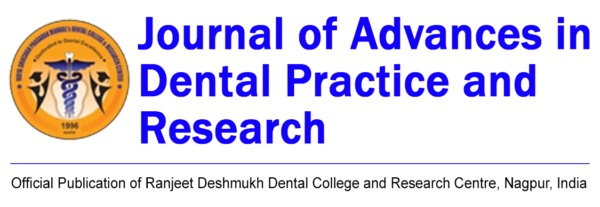Translate this page into:
Evaluation of correlation between emotional intelligence and academic performance in dental students
*Corresponding author: Spruha Sanjay Deshpande, Department of Prosthodontics, VSPM DCRC, Nagpur, Maharashtra, India. spruhasandeshpande@gmail.com
-
Received: ,
Accepted: ,
How to cite this article: Deshpande SS, Tekale R. Evaluation of correlation between emotional intelligence and academic performance in dental students. J Adv Dental Pract Res 2022;1:51-6.
Abstract
Objectives:
Emotional intelligence (EI) serves as a guide to people for recognizing their as well as other persons feelings and make appropriate choices by applying this knowledge. It is also responsible for building stronger relationships, succeeding at work, and achieving personal and professional goals. The aim of the study was to find out correlation between EI and academic performance (AP) in dental students of VSPM Dental College and Research Centre. (VSPM DCRC).
Materials and Methods:
A cross-sectional and observational study was conducted among the students of VSPM DCRC over a period of 6 months. Study participants were interns who had completed 4 years of study, final year students, 3rd-year students, and 2nd-year students of VSPM DCRC.
Results:
A total of 130 students participated in this study. Out of total 130 participants, 104 were females and 26 were males, there is a positive correlation between AP and EI. Since P < 0.05 so the correlation is significant. Furthermore, the value of correlation coefficient (r) is 0.029, thus there is 2% of correlation between EI and AP.
Conclusion:
A positive correlation was observed between EI and AP in students. However, as the EI of majority of students in this study was high, the value of correlation was small.
Keywords
Emotional intelligence
Academic performance
Dental education
Cognitive intelligence
Communication skills
INTRODUCTION
Emotional intelligence (EI) serves as a guide to people for recognizing their feelings and feelings of others and make appropriate choices by applying this knowledge.[1] This helps to accurately perceive, assess and express emotions, and to develop and acquire them into day to day thinking.[2] EI has been associated with positive outcome measures like life and work satisfaction, job performance, and mental well-being.[3] It shows a relation to self-regulations and self-motivation which are important aspects of academic performance (AP). It is also responsible for building stronger relationships, succeeding at work, and achieving personal and professional goals.
In the past, cognitive intelligence has been considered the most important factor in prediction of AP. In conventional education system, more attention is paid to cognitive intelligence. However, studies have shown that it is not the only parameter that can determine AP. The factors which cognitive intelligence cannot measure can be analyzed by EI.[4] AP is not only determined by cognitive intelligence but also by the mental well-being of individual. The mental and emotional well-being of a person are linked with EI.[5] Hence, EI also plays an important role in determining AP of an individual. EI also can help in effective learning. EI has also said to be responsible for 80% of the factors of success.[6]
There are six facets in EI which include self-awareness, self-control, self-confidence, empathy, motivation, and self-competency.[7] Self-awareness means understanding one’s emotions. Self-control is expressing one’s emotions in a controlled way. Self-confidence is having a positive attitude toward oneself. Empathy is being considerate about other people’s feelings. Motivations means showing positive attitude in social dimension. Self-competency means showing appropriate behavior in social dimension. All these qualities help in overall development of an individual and this benefits their growth personally and professionally.[8] This can also help to better AP of students.
People with high EI show better social and communication skills.[9] People with higher EI are also said to have stronger interpersonal relationships.[10] This helps an individual express themselves better. This especially helps in individuals who interact with different people in their professional lives. Building of EI leads to lifelong impact. Some people believe, EI is an acquired trait, while others believe that it is an inborn trait.[1] Hence, they believe that EI can be improved and learned. Some people believe that it can be measured by self-reported questionnaire while others believe it to be a dynamic quality measured by maximal performance measures.
Dental education is believed to be one of the most challenging, demanding, and stressful field of study as students have to acquire several academic, clinical, and interpersonal skills.[8] The course of dentistry in India is of 5 years which include 4 years of study and 1 year of internship. The first 2 years are preclinical years as the student has little to no contact with the patient and the next 2 years are clinical years where the students start treating patients. Due to this in first 2 years, communication skills of students might not be developed, but the next 2 years, the student is required to develop his communication skills so as to talk to the patient. This requires good EI to empathies with the patient and guide them properly. As the students are also assessed based on their communication with the patients, EI forms a very integral part of their AP. In an attempt to better understand what helps students succeed in academics, this will be conducted to assess students’ EI and its associated factors and to determine if there was an association between their EI and academic achievement.
Aim
The aim of the study was to find out correlation between EI and AP in Dental students of VSPM Dental College and Research Centre (VSPM DCRC).
Objectives
The objectives of the study are as follows:
To find out correlation between EI and AP
To find correlation between EI and various demographic factors such as age, gender, and year of study.
MATERIALS AND METHODS
The study was approved by the Institutional Ethical Committee of VSPM DCRC. A cross-sectional study was conducted among the students of VSPM DCRC over a period of 6 months. Study participants included interns who had completed 4 years of study, final year students, 3rd year students, and 2nd year students of VSPM DCRC.
The study tool that was used was a two-part questionnaire which consisted of demographic questions and structured EI questionnaire. The first part consisted of proximal question which included demographic, lifestyle, and professional factors. The demographic factors included gender and year of study. The lifestyle questions consisted of hours of sleep, residence, social interaction, and recreational activities. The professional factors were career choice and AP. This part of the questionnaire consisted of eight questions.
The second part of the questionnaire which comprised of structured questionnaire of EI based on Wong and Law Intelligence scale. It consisted of 16 questions. The first four questions determined self-emotional appraisal. The next four determined others’ emotional appraisal. The next four determined use of emotion and last four determined the regulation of emotion. Responses to the question ranged from 1 = Not so much to 5 = Very much.
The questionnaire was filled by the participants. The participants were made aware about the purpose of the study and proper consent was taken. Students who were willing to participate in our study were included in the study, those who did not give consent or those who did not fill the proforma were excluded from the study.
For EI analysis, the score for each domain was obtained by adding score of the respective domain. The total score was obtained by adding the scores of all domains. The minimum and maximum scores for each domain were 4–20 and total score range was 16–80. The total score <30 was considered poor EI and greater the 30 was considered good EI.
The AP was based on marks obtained in the previous university examination. High and low AP was based on examination percentage >65% and <65%.
Statistical analysis was done by IBM SPSS 2020. Mean and standard deviation were calculated. Test such as Chi-square test and Pearson’s coefficient was used. P < 0.05 was considered significant.
RESULTS
A total of 130 students participated in this study. Out of total 130 participants, 104 were females and 26 were males [Table 1 and Graph 1]. The frequency number of students that participated from 2nd year was 17.7%, from 3rd year was 13.1%, from final year was 6.9%, and from interns was 62.3% [Table 2 and Graph 2].
| Frequency | Percent | |
|---|---|---|
| Female | 104 | 80.0 |
| Male | 26 | 20.0 |
| Total | 130 | 100.0 |

- Frequency of gender of students
| Frequency | Percent | |
|---|---|---|
| 2nd Year | 23 | 17.7 |
| 3rd Year | 17 | 13.1 |
| Final Year | 9 | 6.9 |
| Intern | 81 | 62.3 |
| Total | 130 | 100.0 |
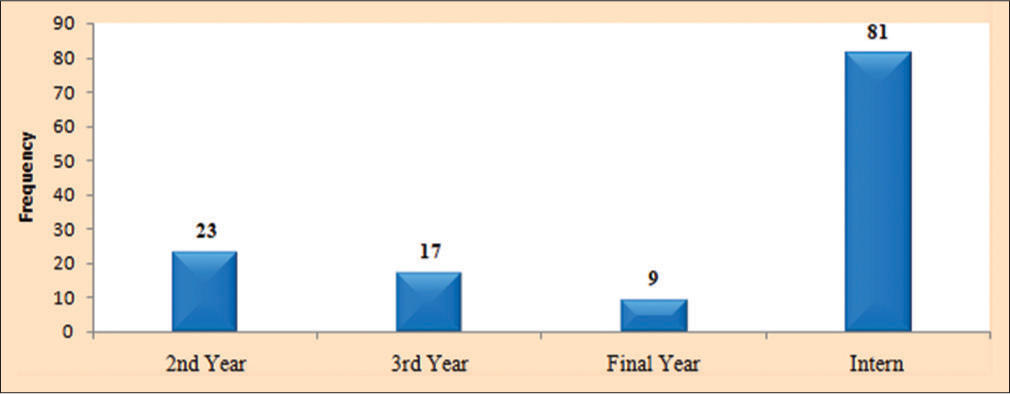
- Years of study of students
The mean values in the four domains were found, for self-emotional appraisal, mean was 13.13, for others’ emotional appraisal, the mean value was 13.56, for use of emotion, mean was 13.50, and for regulation of emotion, mean was 12.06. The value of mean for total score was 52.30 [Table 3 and Graph 3]. The maximum mean score was in others’ emotional appraisal and the minimum mean score was in regulation of emotion. The students who scored more than 65% in examinations had a frequency of 70% and the students who scored <65% had a frequency of 30% [Table 4 and Graph 4].
| n | Minimum | Maximum | Mean | Std. Deviation | |
|---|---|---|---|---|---|
| Self-emotional appraisal | 130 | 4 | 20 | 13.13 | 3.962 |
| Other’s emotional appraisal | 130 | 4 | 20 | 13.56 | 3.848 |
| Use of emotion | 130 | 4 | 20 | 13.50 | 4.010 |
| Regulation of emotion | 130 | 4 | 20 | 12.06 | 4.028 |
| Total Score | 130 | 16 | 80 | 52.30 | 13.996 |
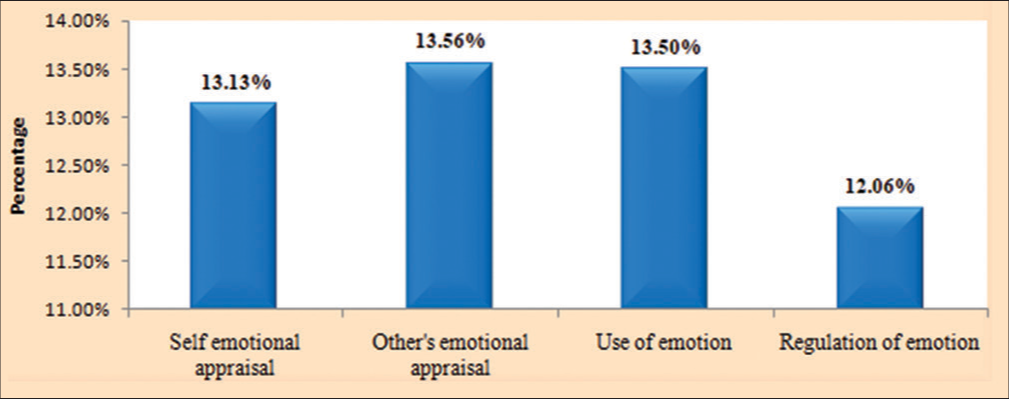
- Comparison of EI factors with marks obtained in recent exam
| Frequency | Percent | |
|---|---|---|
| Greater than 65% | 91 | 70.0 |
| Less than 65% | 39 | 30.0 |
| Total | 130 | 100.0 |
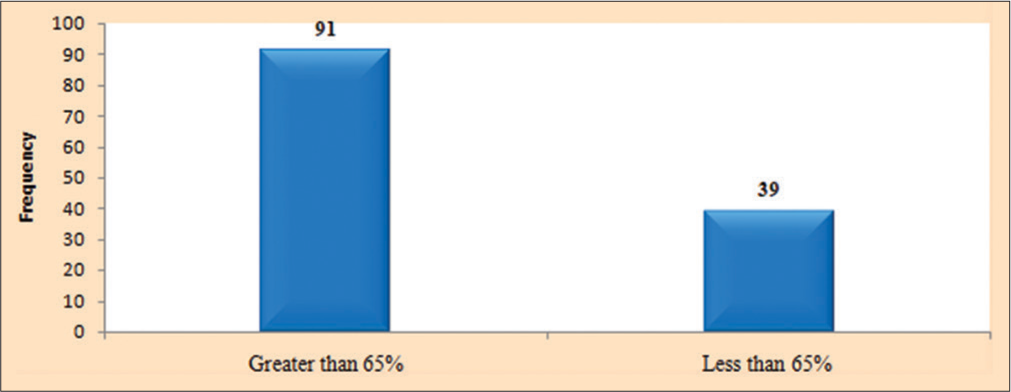
- Marks obtained in recent university exam
The frequency of the question based on lifestyle factor was showed students that sleep for more than 6 h had a frequency of 69.2% and <6 h had a frequency of 30.8% [Table 5 and Graph 5] The frequency of the students who meet their friends regularly was 65.4% and those who do not was 34.6% [Table 6 and Graph 6]. Those students who exercise everyday had a frequency of 29.2% and those who did not had a frequency of70.8% [Table 7 and Graph 7]. Those students who took part in recreational activities regularly had a frequency of 52.3% and those who did not had a frequency of 47.7% [Table 8 and Graph 8]. The frequency of students who joined dental profession by choice was 38.5% and those who did not was 61.5% [Table 9 and Graph 9].
| Frequency | Percent | |
|---|---|---|
| <6 h | 40 | 30.8 |
| More than 6 h | 90 | 69.2 |
| Total | 130 | 100.0 |
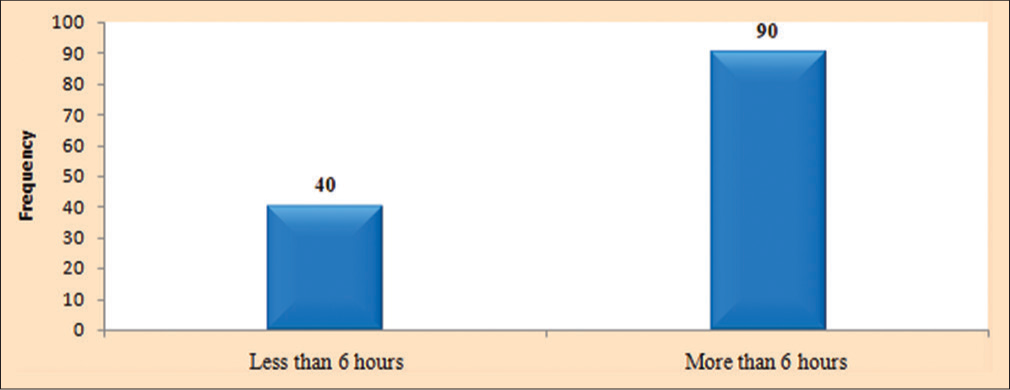
- Frequency of sleeping hours of sleep a student gets
| Frequency | Percent | |
|---|---|---|
| Irregularly | 45 | 34.6 |
| Regularly | 85 | 65.4 |
| Total | 130 | 100.0 |
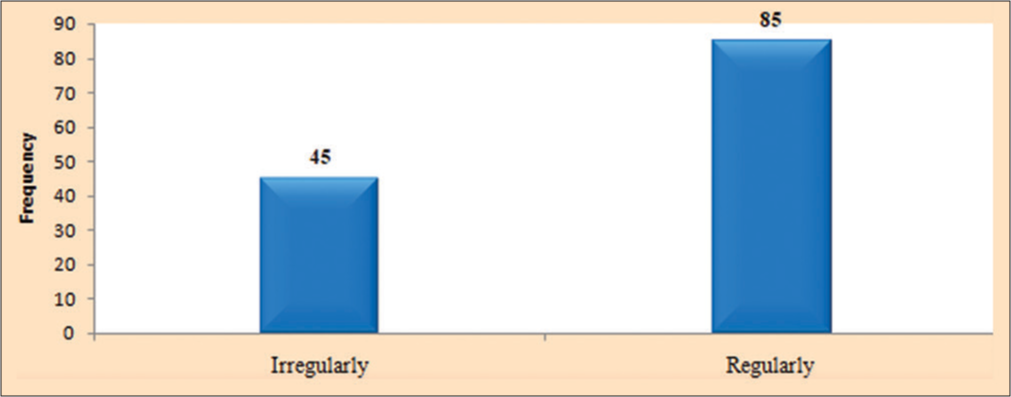
- Frequency of meeting friends
| Frequency | Percent | |
|---|---|---|
| Everyday | 38 | 29.2 |
| Not everyday | 92 | 70.8 |
| Total | 130 | 100.0 |
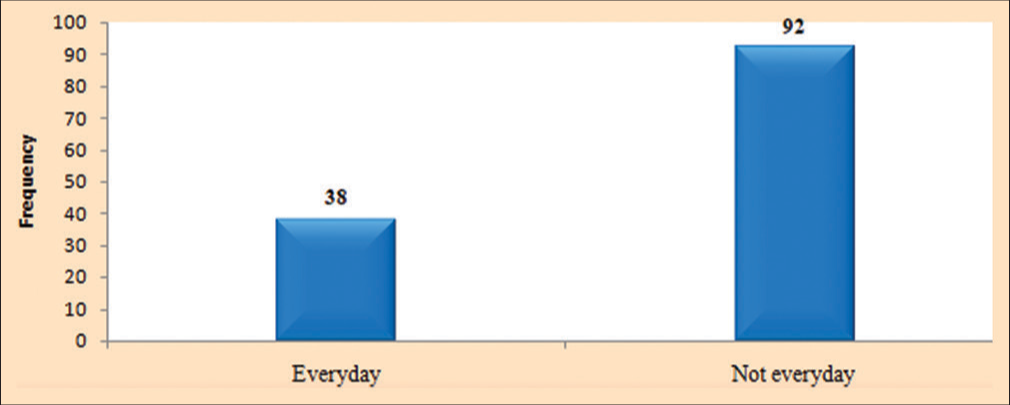
- Frequency of physical exercises done by students
| Frequency | Percent | |
|---|---|---|
| Not so regularly | 62 | 47.7 |
| Regularly | 68 | 52.3 |
| Total | 130 | 100.0 |
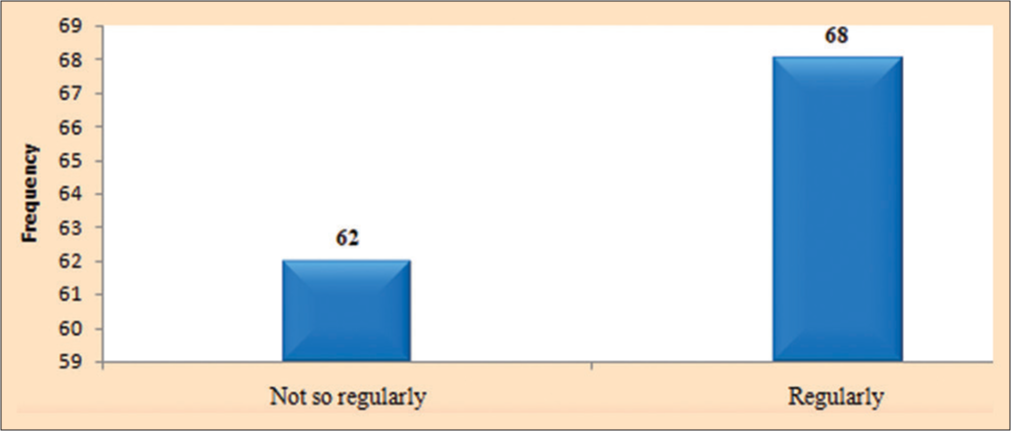
- Participation in recreational activities by students
| Frequency | Percent | |
|---|---|---|
| No | 80 | 61.5 |
| Yes | 50 | 38.5 |
| Total | 130 | 100.0 |
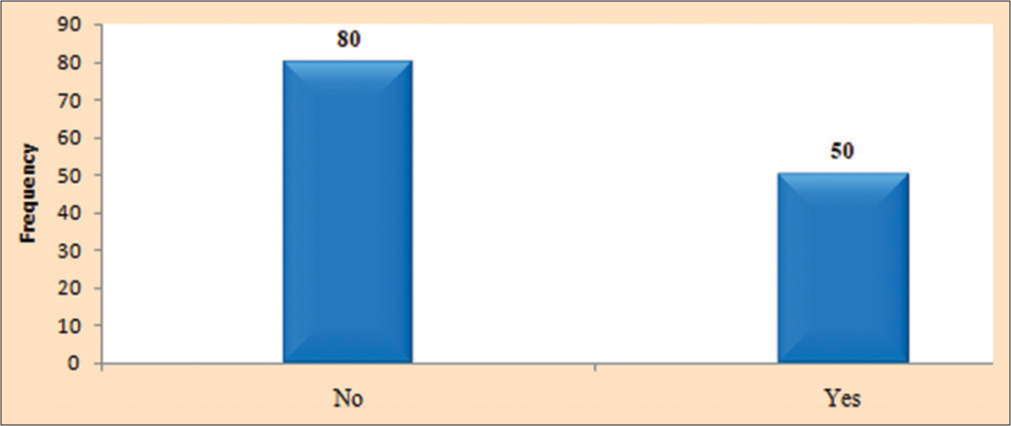
- Frequency of students who joined dental profession by choice
Out of all these factors, the factors which were significantly associated with EI were gender and physical exercise [Table 10].
| EI score | Total | P-value | ||
|---|---|---|---|---|
| ≥30 | ≤30 | |||
| Gender | ||||
| Female | 99 | 5 | 104 | 0.014* |
| Male | 21 | 5 | 26 | |
| Sleeping hours | ||||
| <6 h | 36 | 4 | 40 | 0.510 |
| >6 h | 84 | 6 | 90 | |
| Place of leaving | ||||
| At home | 68 | 6 | 74 | 0.838 |
| At hostel | 52 | 4 | 56 | |
| Meeting friends | ||||
| Irregularly | 43 | 2 | 45 | 0.312 |
| Regularly | 77 | 8 | 85 | |
| Physical exercises | ||||
| Everyday | 31 | 7 | 38 | 0.003* |
| Not everyday | 89 | 3 | 92 | |
| Recreational activities | ||||
| Not so regularly | 58 | 4 | 62 | 0.612 |
| Regularly | 62 | 6 | 68 | |
| Joined profession by choice | ||||
| No | 74 | 6 | 80 | 0.917 |
| Yes | 46 | 4 | 50 | |
From the Tables 11 and 12, it is obtained that there is a positive correlation between AP and EI. Since P < 0.05 so the correlation is significant. Furthermore, the value of correlation coefficient (r) is 0.029, thus there is 2% of correlation between EI and AP.
| EI score | Total | P-value | ||
|---|---|---|---|---|
| ≥30 | ≤30 | |||
| AP | ||||
| ≥65% | 83 | 8 | 91 | 0.001 |
| ≤65% | 37 | 2 | 39 | |
| Total | 120 | 10 | 130 | |
EI: Emotional intelligence, AP: Academic performance
| EI score | AP | |
|---|---|---|
| EI score | ||
| R | 1 | 0.029 |
| P-value | 0.741 | |
| AP | ||
| R | 0.029 | 1 |
| P-value | 0.741 |
EI: Emotional intelligence, AP: Academic performance
DISCUSSION
EI is an important aspect of AP as it helps a dentist make better communication with the patients and be a better dental professional. Dentistry is a profession which not only requires academic and practical knowledge but also social skills to handle a patient. A dentist should be able to recognize a patient’s emotions and then deal with them in a proper way so as to provide a proper treatment to the patient. Conventionally, AP is determined by cognitive intelligence and not a lot of attention is given to EI; hence, this study tried to determine the correlation between these variables as now various other studies have tried to find the association between EI and AP.
Only 7.65% of students had EI <30 and 92.3% had score more than 30. This finding shows us that most of the students who participated in this study had a high EI score this maybe be due to the most participation being from interns who have undergone 4 years of study and out of this had 2 years of patient interaction and also had more opportunities to develop and strengthen their emotional skills. This may be contradicting with the findings of the study conducted by Kumar et al.[1]
EI showed a significant correlation with gender. This is finding that is in line with the study conducted by Shetty et al. This might be because EI depends on expressing ones’ emotions and understanding them. In this case, it might also be because the number of female participants is significantly more than the male participants. Women tend to express themselves more freely than males. Females also try more to recognize their own emotions and to recognize what others are feeling. Males can have difficulty in regulation of their emotions and they do not tend to express themselves as freely as females do.
The lifestyle factors such as sleep, meeting with friends, and recreational activities can also be related to EI. As a person who gets more than 6 h of sleep everyday experiences less sleep deprivation and is more in tune with their emotions. An individual who regularly has social interactions must be good at communication which can improve EI and a person who indulges in recreational activities everyday will be at more peace and can express themselves better. However, in this study, these factors did not show a significant correlation with EI. This contradicts with the study done by Kumar et al. Physical exercise can also influence EI. Physical exercise is important for well-being of not just our body but our mind too. This helps us relieve stress and concentrate more which ultimately leads an individual to live a healthier life. This will help an individual have clear mind and be more calm, regulate emotions better, and have more understanding toward other peoples’ emotions. In this study, physical exercise shows a significant relation with EI.
Social interactions with friends and family are important aspect on an individual’s emotional growth as good communication skills will be needed for the students in their future not only to interact with their patients but also to interact with other dentists and professionals to maintain healthy working relationship. The person staying at home with his family might show positive outcome as they will have good family relations, emotional support, positive peer pressure, social behavior, and parental warmth. These factors can help in emotional growth of an individual which will in turn increase the EI of that individual. This will in turn help them in communicating better and this will help better their AP. However, in this study, these factors do not show a significant relation between where the individual resides and EI.
In proximal factors, the factor which was most significant was gender and other factor was physical exercise.
The correlation coefficient between EI and AP was 0.29 with P = 0.001. This shows the EI and AP have a weak but significant correlation. This might have been because most of the participants in this test had good EI and their AP varied over a range, a strong correlation was not found. Most of the participants in this study were interns who had better EI. Furthermore, this study was carried out in a small group so that might have been responsible for weak correlation of EI with AP.
EI helps in strengthening interpersonal relationships, in showing empathy and recognizing one’s own and others feelings. These characteristics are important in healthcare field like dentistry. The students will need these skills in the future for better understanding of their patients and to become overall better professionals. Hence, more attention should be given to this aspect of learning so it will result in overall development of students and it will increase their skills as a professional. EI will also help them overcome stress and make them better at learning the subjects.
CONCLUSION
A positive correlation was observed between EI and AP in students. However, as the EI of majority of students in this study was high the value of correlation was small. EI also showed significant correlation between gender and lifestyle factor like physical exercise. The study should be carried out on a larger group of population and with groups that have equal gender distribution.
EI is important in AP in dental students. Orientation programs, seminars should be taken to improve the EI of students. The measures for strengthening EI should be included in the curriculum of the students.
Limitations
The limitations of our study are:
- It had unequal gender distribution – more female participants
- It was a questionnaire based study so answers can be biased
- Sample size is small
- Single-center study.
Acknowledgment
The author would like to thank the Dean of college for permitting to conduct the study in this institution and the students who participated in this study for their cooperation and my guide for their guidance and support.
Declaration of patient consent
The authors certify that they have obtained all appropriate patient consent.
Conflicts of interest
There are no conflicts of interest.
Financial support and sponsorship
Nil.
References
- Emotional intelligence and interpersonal relations. J Soc Psychol. 2001;141:523-36.
- [CrossRef] [PubMed] [Google Scholar]
- An analysis of emotional intelligence and academic performance of four-year integrated B. Ed. trainees. Shanlax Int 9 J Educ. 2021;9:108-16.
- [CrossRef] [Google Scholar]
- Emotional intelligence and its association with academic success and performance in medical students. Saudi J Med Med Sci. 2021;9:31-7.
- [CrossRef] [PubMed] [Google Scholar]
- Association between dental students' emotional intelligence and academic performance: A study at six dental colleges in India. J Dent Educ. 2016;80:526-32.
- [CrossRef] [PubMed] [Google Scholar]
- Emotional intelligence and academic achievement of high school students in Kanyakumari District. Int J Phys Soc Sci. 2013;3:101-7.
- [Google Scholar]
- The intelligence of emotional intelligence. Intelligence. 1993;17:432-42.
- [CrossRef] [Google Scholar]
- An assessment of students' emotional intelligence, learning outcomes, and academic efficacy: A correlational study in higher education. PLoS One. 2021;16:e0255428.
- [CrossRef] [PubMed] [Google Scholar]
- Emotional intelligence among Nigerian adolescents: The role of training. J Psychol Clin Psychiatry. 2019;10:191-5.
- [CrossRef] [Google Scholar]
- Emotional intelligence and academic performance in first and final year medical students: A cross-sectional study. BMC Med Educ. 2013;13:44.
- [CrossRef] [PubMed] [Google Scholar]
- Cognition and academic performance: Mediating role of personality characteristics and psychology health. Front Psychol. 2021;12:774548.
- [CrossRef] [PubMed] [Google Scholar]
